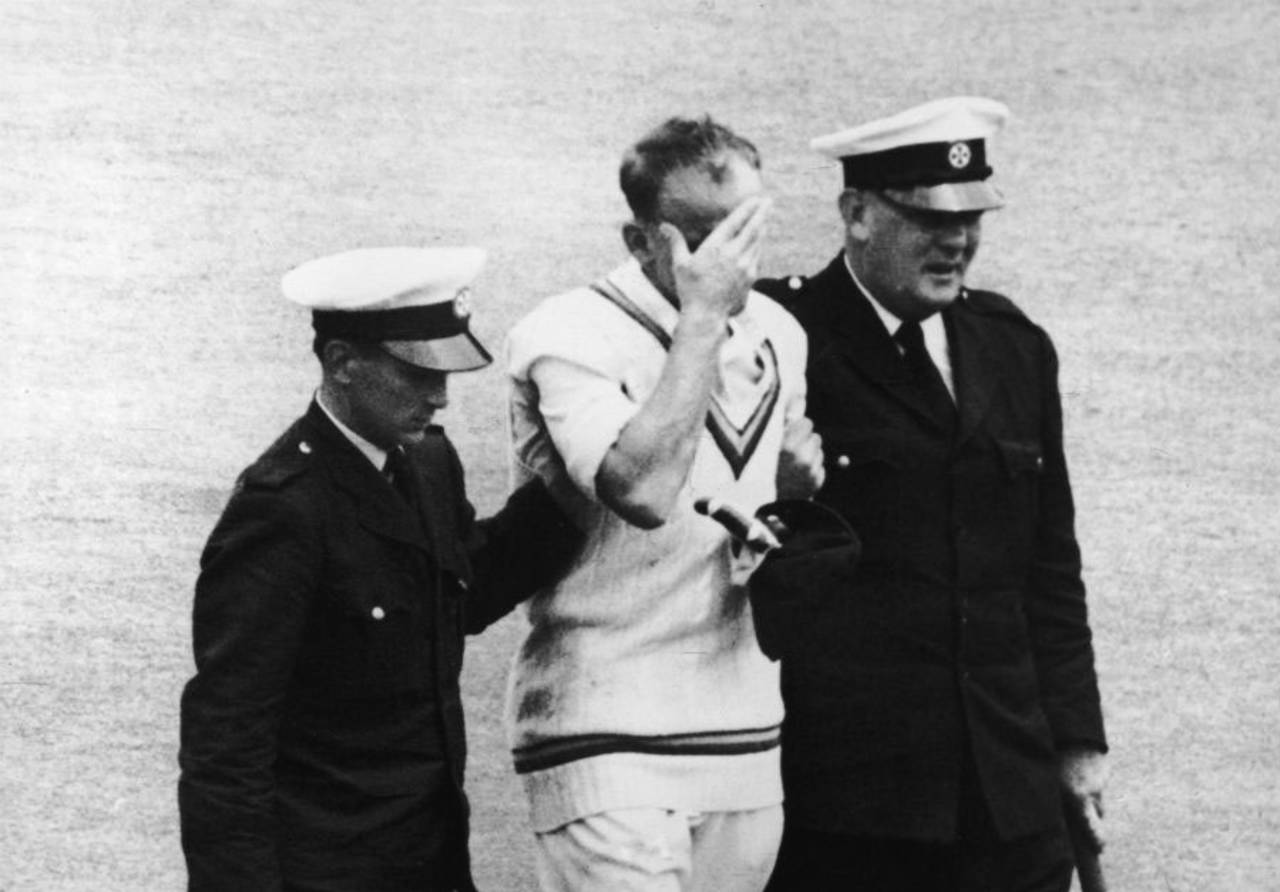It was the first of many stomach-churning moments I've witnessed at Test matches.
Frank Tyson, England's No. 7 batsman, completely lost a bouncer from Australia's master fast bowler Ray Lindwall and was cracked squarely on the back of the skull. Down he went. Head protection for batsmen was unknown in 1954-55. Tyson was wearing only his England cap, and as he lay lifeless on the Sydney turf, many of us thought he might well be dead. It was a long time before he was helped to his feet by the St John's Ambulance men and walked slowly and unsteadily to that lovely old SCG pavilion. It seemed that this might be the end for the poor chap who had taken 1 for 160 in the previous Test,
in Brisbane.
But as we all know, the "Typhoon" came roaring back to take ten wickets in
that match to draw England level after the thrashing they'd endured at the Gabba. Frank's memory of being flattened was so fissured that he was to write later that he was batting at the Hill end, whereas he had been on strike at the Paddington end. I can still picture Godfrey Evans, next man in, grinning nervously as his stubby legs carried him to the middle.
Of that colourful and outstanding Ashes series
of '54-55, the next chapter is fairly well known. Tyson terrified the Australians again
in Melbourne on a dodgy surface that had been secretly and illegally watered overnight after two days' play: 7 for 27 for the Typhoon, and England were not only ahead but now looked invincible.
When we all drove up the winding road through the McPherson Range for a picnic it was usually Frank who drove, and his heavy foot on the brake pedal left the wives in the back ready to parachute out by the time we'd reached the valley
The Ashes had been retained by the time the Poms came back to Sydney for the
final Test, which didn't begin until the fourth morning, so persistent had been the rainfall. Even then, when Australia were asked to follow-on on the final day there seemed just time for England to wrap it up. Tyson bowled off a very short run - and still knocked Keith Miller's bat out of his hands.
The match was drawn, and afterwards (no presentation ceremonies) this teenager hovered around the SCG pavilion, catching sight of Tyson wandering round the dressing room in just a towel and resembling Henry Cooper. Just look at those shoulders. So that was where the power and speed came from. No wonder. For Tyson was no smooth rhythm bowler. It was brute force that gave him his speed and lift. An hour later I saw him emerge, fully and elegantly dressed, and I composed for myself a fantasy: I stood on the pathway exactly 22 yards from him and tried to imagine what he looked like to the poor, doomed Aussie batsmen. The effect was rather spoilt when Frank beamed a pleasant smile.
Some decades later, my wife and I found ourselves living part-time on Queensland's Gold Coast, and enjoying close friendships with Frank and Ursula Tyson (as well as Bill and Judy Johnston). These were idyllic times, when the old battles were revisited, long-hidden facts revealed, triumphs and setbacks re-examined, flaws in the modern game lamented. Frank was vulnerable when it came to one glass of something, and could become quite noisy. But he was always interesting, a man widely read and with broad interests. One evening as the four of us dined in Surfers Paradise, he and I decided to speak French for a while. He was fairly fluent. I was not, and he enjoyed his little verbal triumph.
When we all drove up the winding road through the McPherson Range for a picnic it was usually Frank who drove, and his heavy foot on the brake pedal left the wives in the back ready to parachute out by the time we'd reached the valley. Poor Frank certainly suffered in after years for his express-bowling efforts. The left ankle was damaged beyond repair. But the mind remained sharp, and not so long ago he took up painting. His panorama of Trent Bridge hangs in my library.
I suppose the peak moment of our friendship came when he was coaching the Gold Coast Dolphins in Queensland. One evening just the two of us remained in the nets, so I put on the pads, and it was 1954 again. Which meant that I trembled slightly, for was this not the fastest bowler of all time? Yes, he was now past 60. But I, a long-ago Sydney first-grader, wasn't exactly in my prime either. I treated his medium-pacers with respect. And after a dozen or so deliveries I found that my pal was getting frustrated - not at his own limitations but at my feeble response to his offerings. What he didn't appreciate was that I have an unusually vivid imagination, and I was still seeing the mighty tearaway of '54-55. I couldn't get past that. I was ever ready to duck, but you can't duck gentle half-volleys.
It was a revelation to both of us, I guess. We went off for a beer. Soon we were discussing the possibility of a book on his 1954-55 triumph. In the Eye of the Typhoon came out in 2004, and Frank inscribed it "To David - As John Arlott would have written: 'Something to read on the train.' Thanks for your assistance. Frank Tyson - Surfers January 22nd 2005".
Of all the illustrations in the book the most beguiling is of Frank with his hero Harold Larwood, a photo taken in the latter's lounge room in Sydney. Here sit England's fastest two bowlers of all time, Ashes winners in Australia both of them, and eventually Australian citizens. Is there a moral there somewhere?

